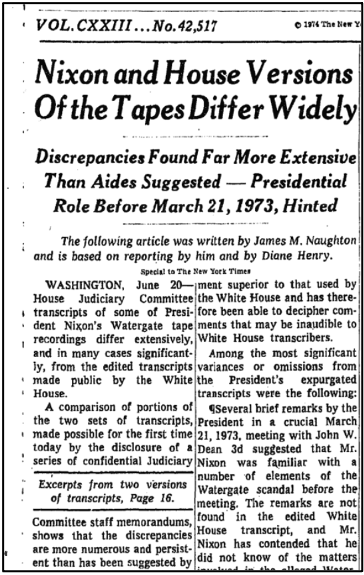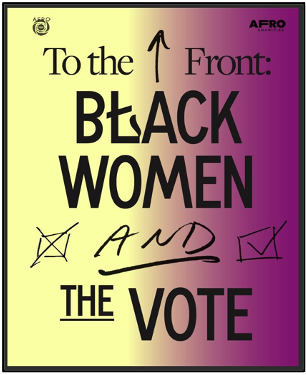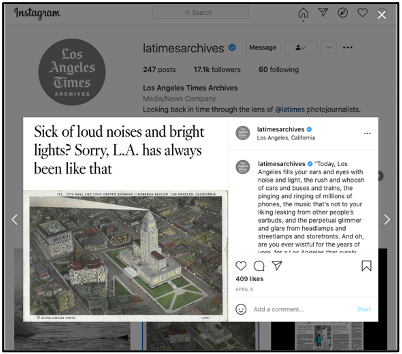News archives: The untapped resource Part 3
Editor’s note: This article, the last of three, is an excerpt of the RJI Fellowship research report: “News archives: The untapped resource.”
This excerpt from the research report highlights the top selections from each of the five categories of examples showing how newsrooms are using the content of their news archives to their benefit.
Each of the categories show different ways that newsrooms gain benefits from their archives in each of the following ways:
- Perspective on current news: by tapping news archives to provide background, context and meaning behind today’s news stories.
- Special news content packages: by rekindling archived content for specialized services or projects including online presentations, pages, web or print sections, books, magazines or video or film, often highlighting important events from the past.
- High reader interest, traffic and engagement: by using archived content to post on highly popular social media channels, especially Instagram and Twitter, to attract readers and viewers, including many in younger age groups who often do not spend time with primary news channels.
- Financial benefits: by using archive access and related services as premium benefits to incentivize paid subscribers, fast becoming the key revenue source as business models shift away from advertising to subscriptions.
- Public or community service: by enabling services or actions in which archive news content is made available as a public service by a company or institution such as a university or public library, museum, non-profit or other types of community groups.
1. Examples: Perspective on current news
When it comes to impact and importance for today’s breaking news, one category is easily the most relevant: current news perspective. In many cases these stories, comparing past events to today’s, can offer critical background that helps readers understand what’s going on in today’s news headlines.
Just as importantly, they can drive considerable online traffic when done promptly, played prominently with links to the latest breaking news, and done with a sharp eye on what readers need to understand today’s news. Here’s one of the best examples of this kind of content.
The Washington Post

Few newsrooms do this as well or as often as The Washington Post’s Brockell and the Retropolis series. This team includes staff members tasked with the job of mining today’s headlines and finding a meaningful connection to the past that can enlighten or explain the news.
When President Donald Trump released a partial transcript in fall 2019 of the much-disputed call with Ukraine’s president, within hours Washington Post online readers were treated to a story about an almost exact parallel from 45 years prior.
“That time Nixon released doctored transcripts during Watergate,” teased the headline on a Sept. 25, 2019 article by Brockell.
In it, she explored President Richard Nixon’s problems when he gave Congress only transcript excerpts of the infamous Oval Office tapes and claimed they exonerated him. Later release of the full tapes showed the opposite, similar to testimony by Trump administration officials that seemed to upend his claim that his call transcript showed no quid pro quo in pushing Ukraine to investigate an opponent.
More stories based on the Post’s and other news archives followed: a piece on the Supreme Court ruling that forced Nixon to hand tapes over to investigators, another on how the GOP scuttled the political career of the one House member who broke with Nixon, and a story about the one person other than Woodward and Bernstein who knew the identity of Deep Throat.
The Retropolis series dips into news archives and other historical resources to provide perspective on today’s breaking news headlines. Started in 2017, it became so popular at one point in 2018 that the Post added a podcast that ran for several years, and in 2019 hired Brockell as its first full-time reporter for the series. Retropolis stories have such a strong following that the Post often presents them prominently on the home page of its main website.
What accounts for the popularity of this series of stories offering perspective on breaking news?
“One word: context,” Brockell says. “Everything that’s happening in the news today, if you look at our history you can get the context on why this matters, what’s changed, what hasn’t changed, and how to understand it all.”
What made this possible at the Post was a commitment by editors such as Enterprise Editor Lynda Robinson to support this series with resources, including Brockell and other reporters such as Michael Ruane who make frequent repeated contributions.
While this level of commitment may not be possible at most newsrooms, the success of the Post’s Retropolis series can still provide strong evidence of the value of providing at least some resources for such reader-friendly and popular work.
2. Examples: Special news content packages
One approach that’s proven popular with readers are the many special news projects and products, a category in which widely varying types of existing news content is re-published or re-packaged, and sometimes re-interpreted in new forms that leverage a unique story.
It can be a simple but brilliant idea such as the package The Chicago Tribune did on election day 2020, presenting front page images of the last 27 presidential elections going back 100 years to 1920, with huge screaming headlines such as “Landslide for Ike!” and the infamous “DEWEY DEFEATS TRUMAN” banner headline showing an early edition front page based on incomplete results of the 1948 presidential election.
What sets these apart and makes them appealing is that in most cases, according to the reporters and editors I spoke with, they involve significant research, planning and preparation, as well as production efforts specific to each media form.
And they often involve another key characteristic: they take advantage of content that exists nowhere else but in their own unique news archive collections. News content that was gathered in their own community, published for their own readers or viewers and preserved ever since, making it possible to retell or reinterpret stories that hold great meaning to the life of a city or state, sometimes telling them in new ways and with a new perspective that adds heightened understanding to something long forgotten.
Here’s one of the best examples of this kind of special news content.
To The Front: Black Women And The Vote — Baltimore Afro-American

When the Baltimore Afro-American realized the 100th anniversary of the 20th Amendment was coming up, they decided it was time to tell the little-known story of the role Black women played in the struggle to win equal voting rights for America’s women.
The project launched Archives Manager Savannah Wood on a search through the 128-year-old collection of one of the oldest Black newspapers in America. What she found was a detailed record of news stories on the public meetings, strategy sessions and debates by Black suffrage leaders in Baltimore and nearby Washington, DC in the decades leading up to 1920. But along the way, Wood also found great human stories about the meaning and impact on real individuals of the bigotry and discrimination of the era.
People such as Frances Ellen Watkins Harper, a poet who lectured on anti-slavery in the 1850s and was a founding member of the American Woman Suffrage Association and the National Association of Colored Women.
“As much as white women need the ballot,” she told a New York convention of this group after touring conditions in the South, “Colored women need it more.”
To celebrate this untold story, Wood gathered newspaper clips and photos from the newspaper along with historical documents into a new book: To The Front: Black Women and The Vote, published in May 2020 by the Afro-American newspaper and its charity arm, Afro-Charities Inc.
This 118-page volume is a keepsake publication that draws deeply from the rich archives of the Afro-American, which has been publishing continuously since it was founded in 1892 by Wood’s great, great grandfather. And it’s these archives, carefully preserved and tended over 128 years by the family of its founder, that made this book possible.
The project was supported in part through a grant from Facebook. It includes not only original news stories and photos from the time, but also profiles of key women who were deeply involved in the years of struggle to gain the right to vote.
The book was the publisher’s idea, Wood recalled. “She wanted to do something to honor the 100-year anniversary of Black women in the suffrage movement. Because the Afro goes so far back, many of those documents about this would be in our archives. So this is a great place to look for this material.”
“We’re really trying to celebrate the people who were involved in this whose names might not be recognized,” Wood said.
Women such as Ida R. Cummings, the first African American kindergarten teacher in the Maryland public school system in 1901. And Martha Elizabeth Howard Murphy, a founder and leader of the YWCA for Blacks in Baltimore. Murphy played a key role in helping her husband start the Baltimore Afro American, using money from the sale of family farmland as seed funding. It also highlights the work of groups like the DuBois Circle, first formed in 1906 by five black Baltimore women, and still going more than a century later.
The book is available through the Baltimore Afro-American’s website, and other Baltimore outlets.14
3. Examples: High reader interest, traffic, engagement

Some of the most modern methods of using news archives are the social media channels and related digital channels that ride their growing dominance to capture readers who spend increasing amounts of time on their mobile devices. It’s a variation on the business adage to go where your readers, viewers, listeners are. Increasingly these days, that means social media, mobile apps and email newsletters.
Chief among these are Twitter and Instagram, along with some presence on Facebook and a few other services. In these digital arenas, newsrooms doing this best are taking advantage of the unique capabilities of social media services for interacting with readers, to build direct audiences, drive traffic to a website or other channels, and build stronger audience relationships.
For this approach we find few of the old-style “Today-In-History” columns or features that once appeared across America’s daily news. Instead, the focus is on channels such as Instagram, which is structured specifically around photo and video content.
“Sick of loud noises and bright lights?” asked a recent Instagram post by the Los Angeles Times. “Sorry, LA has always been like that.” The post plugs a story by LA-whisperer Patt Morrison, who mined the Times’ news archives for past examples of public gongs and sirens, trains bells and noises, along with the blinding lights of lighthouses along the Pacific shore and other beacons ranging from the Hollywood movie debut searchlights to the huge rotating beacon that once shone from atop City Hall.
Instagram and Twitter channels common
The Chicago Tribune is also active on social media, regularly posting archived photos on its highly popular Vintage Chicago channel on Instagram, where you’ll find a wide variety of images ranging from gymnasts at a 1948 Swedish Festival in Grant Park to construction workers toiling high atop the former Sears Tower in 1973.
TV stations and networks are also taking this approach, including the NBC News Archives, which posts news video clips on its Twitter channel from the recent past as well as older content, such as a 1963 clip of baseball legend Jackie Robinson attending a rally with actor Harry Bellafonte.
Many smaller and regional news organizations are active as well, including the Arizona Republic, which launched an AZArchives Instagram channel in 2020 “as a way for us to travel back in time, however briefly, to the people and places that have enriched Arizona’s history,” according to its web site.
The Associated Press manages major social media archival channels, including the AP Archive and AP Images, both on Twitter. Recent posts include a lookback at the American invasion of Okinawa in 1945, and an interview with young members of the Rolling Stones in 1971. The AP Images channel, which focuses solely on Associated Press photography, recently posted images such as an artist sketching in Jackson Square in New Orleans in 1960.
One newspaper found it effective to use Facebook groups such as a group for people who grew up in the Tampa Bay area, along with Twitter, to crowdsource ideas and comments for stories. One such story looked back on why the Tampa airport is so popular, tapping the Tampa Bay Times archives for explanations. What reporter Elizabeth Djinis found in a 1996 archived story was that airport designers in 1971 built star-shaped concourses aimed at limiting passenger walks to no more than 600 feet. Djinis, who now runs an independent journalism and social media service, said that after the stories were done, they used the Facebook groups to promote the stories and drive traffic.
4. Examples: Financial benefits in leveraging archives
While the examples cited in this report are clearly popular with readers, hard data on additional traffic, increased subscriptions and revenue is difficult, if not impossible, to gauge.
There are indicators, however, that support the main proposition of this research project: that news organizations which use their archive as critical content that readers are interested in will benefit from it in substantial ways. Here’s one example of what we do know.
Social media indicators
One segment where partial data is available is the follower counts that appear on some social media channels, including Twitter and Instagram.
The Los Angeles Times Archive, for example, has a strong following of more than 17,000 followers of its Instagram page, where it posts photos and illustrations from the archive, along with brief summaries that tell the story of each. For the Arizona Republic Archives channel on Instagram, the followers total 1,670 recently. The numbers are higher for the Vintage Tribune Instagram channel run by the Chicago Tribune, with more than 93,000 followers viewing posts showing photos from more than a century of news photography of that city.
On Twitter, Brockell, of the Washington Post’s Retropolis, has gathered more than 11,000 followers in just a couple of years for this popular series of stories that provide context for current and breaking news. Tina Jordan, Deputy Editor of the New York Times Book Review, who writes often from the Times’ archive, has more than 14,000 followers for her stories.
The numbers are even higher for large media organizations with a strong social media presence for their archives, including the BBC Archive, which has over 69,000 followers on Instagram and over 245,000 on Twitter for posts looking back on key news events as well as popular entertainment programs.
The Associated Press Archive has similar numbers, with more than 189,000 followers on Twitter for posts of still and video news images. The New York Times Archive also has a strong presence on Instagram, with 261,000 followers for posts that look back on key news events and share archive photos of general interest. The Times does not use Twitter for this type of content.
While in most cases these numbers are small compared to the number of followers on the news organization’s main Instagram or Twitter channels, they are nonetheless significant. The L.A. Times’ main Instagram channel, for example, has 763,000 followers, while the Chicago Tribune’s Twitter channel has 1.1 million. But it’s worth noting that the Tribune’s Vintage Tribune channel on Instagram has almost half the followers as the newspaper’s main Instagram channel.
5. Examples: Public service news archives
The last category of examples involves services or collections that serve some public benefit. What distinguishes this group of examples is that they each contribute in some significant way to either ensuring the long-term preservation of irreplaceable past news content, or they aid or provide access to archived news content for the public. These are also generally public institutions or non-profit organizations.
While some of the examples above include services with public access elements, this group of examples focuses primarily on this kind of benefit, the long-term benefit to the public. Here are two of the best examples.
Chicago History Museum’s Millions of Moments
One such effort is the Chicago History Museum’s recent acquisition of digitized negatives from the Chicago Sun-Times. This collection represents a unique story of photos that had been lost to the public record for some years but were rescued and recovered in 2017 from a warehouse in Dixon, IL. The photos had been sold to a memorabilia collector later convicted of fraud and languished for years unidentified in the warehouse.
As of early 2021 the museum had made 165,042 photos available publicly, out of a total of five million negative frames recovered from the warehouse. Photos in the collection, called “Millions of Moments: The Chicago Sun-Times Photo Collection,” range across the full spectrum of events and news topics the newspaper covered over Chicago’s history, from sports to street protests to the massive parade for the Apollo 13 crew through the city in 1970.
“Newspaper photography — newspaper photo morgues — are really a critical part of the story and a great opportunity to create a visual record of a changing city,” John Russick, museum vice president for interpretation and education told the Sun-Times last year. “They’re visually documenting change over time, and in that visual record is an incredible story of the city of Chicago.”
WGBH and the American Archive of Public Broadcasting
One of the most significant developments in preservation of television content is the American Archive of Public Broadcasting, a collaborative effort begun in 2013 by GBH (formerly WGBH-TV) in Boston and the Library of Congress. This service offers more than 40,000 hours of television from more than 100 public TV stations across the country, some going back to the 1940s. Some of this content is available on the AAPB website for public viewing.
This collection includes special online exhibits on topics of special interest, such as an exhibit of news clips from the closely followed Watergate hearings Congress held in 1974 and a series of news clips called “Voices of Democracy: Public Media and the Presidential Elections.” The collection also includes non-news content.
WGBH itself maintains a comprehensive archive of news and entertainment content created over more than 60 years since it first went on the air. This site also includes OpenVault, which provides access to special online exhibits of news footage such as “The Vietnam Collection,” about coverage of the Vietnam War; and “Freedom Riders Interviews” with participants in the 1961 protests. It also hosts the Boston TV News Digital Library, which hosts an archive of The Ten O’Clock News, WGBH’s in-depth nightly news program, which aired daily from its launch in 1974 until 1991.
This is part of a series of excerpts of the RJI Fellowship research report: “News archives: The untapped resource.” Here are links to all three parts:
- Part 1 – “Value, importance of good news archives can’t be overstated”
- Part 2 – “Five ways that newsrooms find great value in news archives”
- Part 3 – “Creative examples show deep value of news archives”
Read the full report, with full details on ways newsrooms are tapping their news archives.
Also, don’t miss the larger, in-depth research project for which this was a companion report, “Endangered But Not Too Late: The State of Digital News Preservation.”

Comments